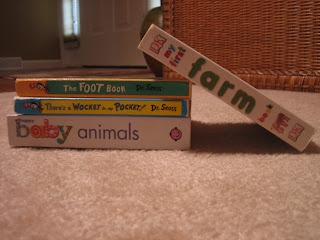
Let's face it. Most little ones like to play with cars. My guy must have a collection of at least 30. So why not take advantage of this obsession by teaching them a little bit about motion? Even at the young age of barely 2, my son enjoys this activity; although I'm sure he's not actually learning about the science part yet. But that's fine because he likes it and it introduces him to an activity that we can build on in the future. All you need are some books to build ramps, a toy car, and a stopwatch. You can also use a ruler or meter stick with older kids.
Build a ramp by stacking the books and using one as the actual "ramp". Place the car at the top of the ramp. Release the car, using the stopwatch to time how long the car is in motion - be sure not to push the car and definitely let the car stop on its own. Now ask your child what might happen if you add a book to make the ramp higher. Add the book and time the car again. Discuss what happened. You can also try doing this on different surfaces. For example, if you set the ramps up on carpet, try setting them up on a hardwood floor. Ask your child which surface might make the car go faster and why. For older kids, the meter stick can be used to measure the distance the car traveled each time. Simply leave the car where it stopped and measure the distance from the end of the ramp to the car.
So what's going on here? As you may have guessed, the car will be in motion longer when released from higher ramps. That's because it will have greater velocity (directional speed), so it will have greater momentum, meaning it's harder for air resistance to slow it down to a stop. The car will also be in motion longer when traveling across a smooth surface. This has to do with friction - the wheels encounter less friction on smooth surfaces, so the car moves at a greater velocity, has more momentum, blah, blah, blah (sometimes physics makes me nervous, like I'm going to say the wrong thing or use the wrong terminology - it all just sounds so fancy sometimes). That's why people spread sand...or cat litter...or gravel... on an icy sidewalk - the sand increases friction between the sidewalk and shoes so a person is less likely to slip and fall.



3 comments:
We should time the cars going down your railing. So perfect! And so in your future! HA HA :)
I don't know, I think my next physics experiment will be building a zip line from the pool wall to the street below. Then I'll test it using different masses. Do you think it will hold me? :)
Just let us boys test it. By the way, I think the boy has a collection closer to 50 cars. For some reason, he still does not think that's enough.
Post a Comment